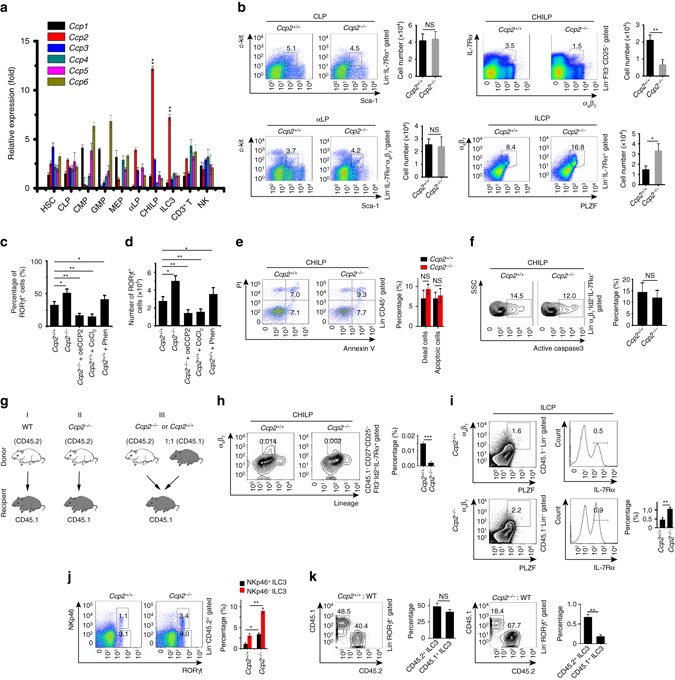Fig. 2.

CCP2 deficiency potentiates ILC3 differentiation from CHILPs. a Total RNAs were extracted from hematopoietic populations. Indicated gene expression levels of Ccp1, Ccp2, Ccp3, Ccp4, Ccp5, and Ccp6 were examined by real-time qPCR. b Gating strategies and flow cytometry analysis of CLP (Lin−IL-7Rα+Sca-1lowc-Kitlow), αLP (Lin−IL-7Rα+Sca-1+c-Kit+α4β7 +), CHILP (Lin−IL-7Rα+Flt3−CD25−α4β7 +), and ILCP (Lin−IL-7Rα+α4β7 +PLZF+) in BM from Ccp2 +/+ and Ccp2 −/− mice. n = 6 per group. Numbers of indicated cells in Ccp2 +/+ and Ccp2 −/− mice were calculated as shown means±s.d. c, d CHILPs were isolated from Ccp2 +/+ or Ccp2 −/− mice and cultured on OP9 cells in the presence of SCF and IL-7 for 12 days. Percentages c and total numbers d of ILC3s were examined by flow cytometry, gated on CD45+Lin−RORγt+. The CCP agonist CoCl2 (10 μm) and antagonist Phen (2 μm) were added for in vitro differentiation assays. e Apoptosis of CHILPs from Ccp2 +/+ and Ccp2 −/− mice was analyzed with Annexin V/PI. Apoptotic cells were calculated and shown as means±s.d. f Active caspase 3 in CHILPs from Ccp2 +/+ and Ccp2 −/− mice was detected by flow cytometry. g Schematic representation for BM transplantation assays. h–j 5 × 104 CD45.2+ LSK from Ccp2 +/+ or Ccp2 −/− mice with 5 × 106 CD45.1+ helper cells were transplanted into lethally irradiated CD45.1+ recipients. After 8 weeks, percentages of CHILPs h, ILCP i, and ILC3s j in chimeras were checked by FACS. n = 6 for each group. k A 50/50 mixture of CD45.1+ wild-type and CD45.2+ Ccp2 +/+ or Ccp2 −/− bone marrow was transplanted into lethally irradiated CD45.1+ recipients. The ratio of CD45.1+ to CD45.2+ ILC3s in chimeras (n = 6) were analyzed by gating on CD45.2+Lin−RORγt+ (Ccp2 +/+ or Ccp2 −/−) and CD45.1+Lin−RORγt+ (WT). *P < 0.05, **P < 0.01 (Student’s t-test). Data are representative of three independent experiments. Error bars in a–f and h–k indicate s.d.
